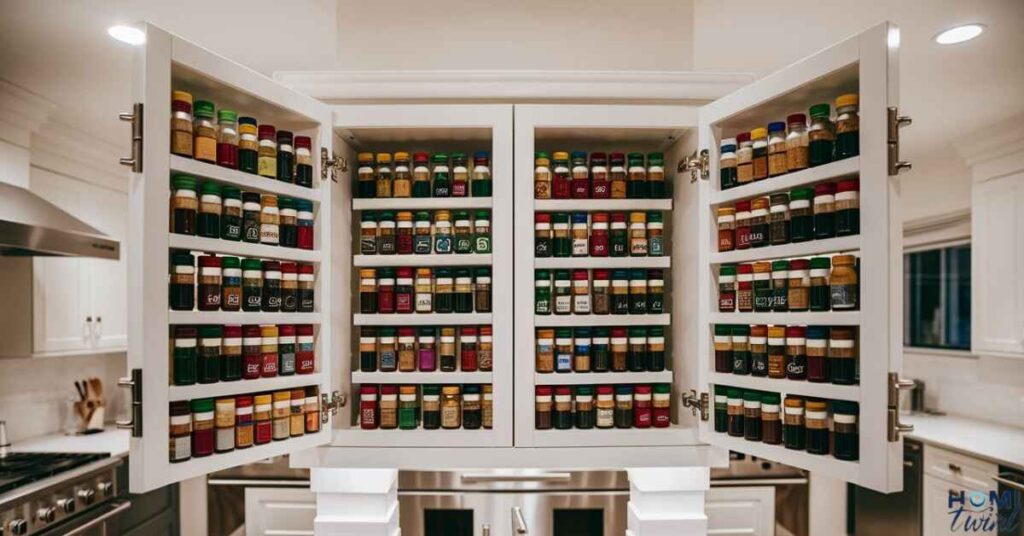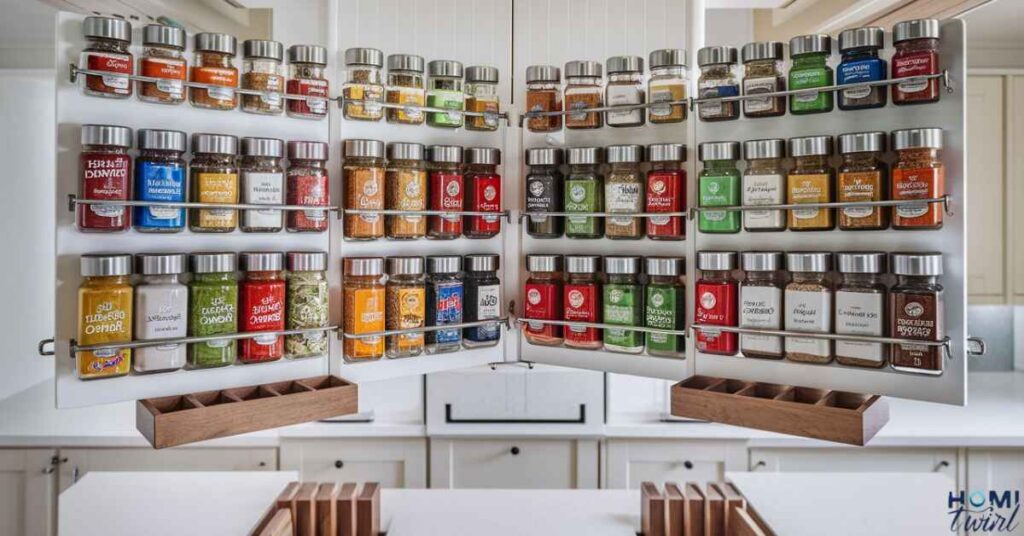Does your spice cabinet resemble a chaotic jumble of bottles and jars? It’s time to regain control and transform that cluttered space into an organized oasis.
An efficiently arranged spice cabinet saves you time, reduces waste, and elevates your cooking experience. In this guide, we’ll walk you through a step-by-step process to declutter, categorize, and creatively store your spices.
Say goodbye to frustrating searches and hello to a streamlined system that simplifies meal prep. Get ready to unlock the full potential of your kitchen and become a master of spice organization!
Why An Organized Spice Cabinet Matters

Before we dive into the how, let’s explore the compelling reasons why an organized spice cabinet should be a top priority for every home cook:
- Save Time When Cooking: With a well-organized system, you’ll be able to quickly locate the spices you need, streamlining your meal preparation process and eliminating frustrating searches.
- Avoid Buying Duplicates and Reduce Waste: Have you ever purchased a duplicate spice because you couldn’t find the one you already had? An organized cabinet ensures you have a clear view of your inventory, preventing unnecessary purchases and minimizing waste.
- Create a Neat, Streamlined Look: Let’s be honest – a cluttered, chaotic spice cabinet is an eyesore. By organizing your spices, you’ll instantly elevate the aesthetic appeal of your kitchen, creating a neat and visually pleasing environment that you’ll take pride in.
With these compelling benefits in mind, let’s dive into the step-by-step process of achieving spice cabinet nirvana.
Read This Blog: HOW LONG DOES IT TAKE TO INSTALL KITCHEN CABINETS
Step-by-Step Guide to Organizing Your Spice Cabinet
Follow these simple steps to transform your spice cabinet into a well-oiled machine of organization.
Step 1: Take Inventory and Check Expiration Dates
Before you begin the organization process, it’s crucial to take stock of your current spice collection. Start by removing all the spices from your cabinet and placing them on a clean surface. Take this opportunity to inspect each bottle or container, checking for expiration dates and discarding any old, stale, or unlabeled spices.
Pro Tip: Don’t rely solely on expiration dates; give your spices the sniff test. If they lack aroma or potency, it’s time to bid them farewell.
Step 2: Clean Out the Cabinet Thoroughly
With your spice collection temporarily removed, it’s the perfect time to give your cabinet a deep clean. Remove any lingering dust, crumbs, or spills, ensuring you have a fresh slate to work with. Consider lining the cabinet with fresh shelf paper or contact paper for an extra touch of organization and cleanliness.
Step 3: Invest in Practical Storage Containers
Uniform storage containers are the key to achieving a cohesive, visually appealing spice cabinet. opt for clear glass jars or airtight containers that not only protect your spices from moisture and sunlight but also allow you to easily identify their contents. Consider investing in a label maker or using masking tape and a permanent marker to clearly label each container.
Alternatively, you can repurpose unique containers like test tubes or decorative tins to add a touch of personality to your spice collection.
Step 4: Group Spices by Category
Now it’s time to organize your spices into logical categories. Consider grouping them based on their primary use, such as baking spices, ethnic cuisines, or frequently used spices. This system will make it easier to locate the spices you need quickly, streamlining your cooking process.
You can take this a step further by arranging the spices within each category alphabetically or by frequency of use, with the most commonly used spices placed at the front for easy access.
Step 5: Label Everything Clearly
Clear labeling is paramount in maintaining an organized spice cabinet. Use a label maker or neat handwriting to label each container with the spice name, as well as any additional information you find helpful, such as the expiration date or country of origin.
For a cohesive look, consider using uniform labels or a consistent font and color scheme throughout your spice collection.
Pro Tips for Long-Lasting Spice Cabinet Organization

Now that you’ve mastered the basics of spice cabinet organization, let’s explore some pro tips to ensure your hard work stays intact.
- Store Spices in a Cool, Dark Place Away from Heat: Heat and sunlight can cause spices to lose their potency and flavor quickly. Keep your spice cabinet away from direct sunlight and heat sources like the oven or stove.
Also Read This Blog: WHAT TO PUT IN GLASS KITCHEN CABINETS
- Buy Spices in Smaller Quantities to Prevent Spoilage: While bulk buying may seem cost-effective, it’s better to purchase smaller quantities of spices to ensure freshness and prevent waste from expired or stale spices.
- Use a Lazy Susan or Tiered Racks for Visibility: For deep cabinets or shelves, consider using a Lazy Susan or tiered racks to maximize visibility and accessibility of your spice collection.
- Add a Fresh Lining or Shelf Paper for a Clean Look: A fresh lining or shelf paper not only adds a touch of style to your spice cabinet but also makes it easier to wipe down and maintain cleanliness.
Getting Creative with Spice Storage
While a dedicated spice cabinet is the traditional approach, don’t be afraid to think outside the box when it comes to spice storage solutions. Here are some creative ideas to consider.
- Mount a Magnetic Knife Rack on the Cabinet Door: Transform the inside of your cabinet door into a functional spice storage area by mounting a magnetic knife rack and using it to hold small jars or tins.
- Use Drawer Inserts or Dividers for Deep Drawers: If you have deep kitchen drawers, consider using drawer inserts or dividers to create compartments for your spice collection, ensuring easy access and visibility.
- Repurpose Unique Containers: Get creative with your spice storage by repurposing unique containers like test tubes, decorative tins, or even recycled glass jars. Not only will this add personality to your kitchen, but it’s also an eco-friendly way to reduce waste.
Maintaining an Organized Spice Cabinet Long-Term
Organizing your spice cabinet is a significant investment of time and effort, but the real challenge lies in maintaining that hard-earned organization. Here are some tips to help you keep your spice cabinet in tip-top shape.
- Schedule Seasonal Decluttering Sessions: Set a reminder on your calendar to declutter and reorganize your spice cabinet every few months. This will help you identify and discard any expired or stale spices, ensuring your collection stays fresh and organized.
- Establish a “One In, One Out” Policy: When introducing a new spice to your collection, make a conscious effort to remove an old or rarely used spice. This simple rule will prevent your cabinet from becoming overcrowded and cluttered over time.
- Share Responsibility – Get Family Involved: Enlist the help of your family members in maintaining the organization of your spice cabinet. Assign specific tasks, such as checking expiration dates or alphabetizing spices, to ensure everyone contributes to the upkeep.
- Label and Date New Spice Additions: When adding new spices to your collection, make sure to label them clearly with the spice name and the date of purchase. This will help you keep track of expiration dates and usage.
Storage Solutions for Every Kitchen

Not every kitchen is created equal, and the same organization methods may not work for everyone. That’s why it’s essential to explore different storage solutions tailored to your unique kitchen layout and needs.
Spice Drawer Organization
If cabinet space is limited in your kitchen, consider transforming a drawer into a dedicated spice storage area. Drawer organizers and inserts can help you efficiently utilize this space, ensuring your spices are easily accessible and visible.
Here are some tips for organizing a spice drawer.
- Use clear, uniform containers for easy identification.
- Arrange spices by category or frequency of use.
- Utilize drawer dividers or inserts to keep everything in place.
- Place most frequently used spices at the front for quick access.
Wall-Mounted Spice Racks
For a space-saving solution that keeps your spices within arm’s reach, consider installing a wall-mounted spice rack. These racks can be mounted on an empty wall or even inside a cabinet door, maximizing your storage options.
When choosing a wall-mounted spice rack, consider the following factors.
- Size: Measure the available wall space to ensure the rack will fit comfortably.
- Capacity: opt for a rack with enough slots or compartments to accommodate your entire spice collection.
- Style: From rustic wooden racks to sleek, modern designs, choose a style that complements your kitchen’s aesthetic.
Spice Carousel or Lazy Susan
For deep cabinets or pantries, a spice carousel or Lazy Susan can be a game-changer. These rotating trays ensure that every spice is easily accessible and visible, eliminating the need to rummage through the back of your cabinet.
When using a spice carousel or Lazy Susan, consider the following tips.
- Arrange spices by category or frequency of use for easy retrieval.
- Label each container clearly to identify the contents at a glance.
- Adjust the height of the carousel or Lazy Susan for comfortable access.
Embracing Minimalism: Decluttering Your Spice Collection

As you embark on your spice organization journey, it’s essential to embrace a minimalist mindset. A cluttered, overcrowded spice collection can quickly undo all your hard work, so it’s crucial to declutter regularly.
Here are some tips for decluttering your spice collection.
- Check expiration dates: Discard any spices that have expired or lost their potency.
- Consolidate duplicates: If you have multiple containers of the same spice, consolidate them into one container.
- Eliminate rarely used spices: Be honest with yourself – if you haven’t used a particular spice in over a year, it’s time to let it go.
- Adopt the “one in, one out” rule: When introducing a new spice to your collection, remove an old or rarely used spice to maintain balance.
By decluttering your spice collection regularly, you’ll not only maintain an organized space but also ensure that you’re using fresh, high-quality spices in your cooking.
Get Creative: DIY Spice Storage Ideas
If you’re feeling particularly crafty or want to add a personal touch to your spice organization, consider exploring some DIY spice storage ideas. These projects can not only provide functional storage solutions but also serve as decorative accent pieces in your kitchen.
Repurposed Containers
Get creative by repurposing old containers or household items as spice storage. From vintage tins and mason jars to recycled glass bottles or even old ceramic mugs, the possibilities are endless.
Here are some tips for repurposing containers.
- Ensure the containers are clean, dry, and airtight.
- Add labels or chalkboard paint for easy identification.
- Arrange the containers on a tray, shelf, or wall-mounted rack for a cohesive display.
Magnetic Spice Tins
Transform your refrigerator or a magnetic board into a spice storage area by creating magnetic spice tins. This not only keeps your spices within easy reach but also adds a touch of quirky charm to your kitchen.
Here’s how to make magnetic spice tins.
- Collect small, airtight tins or containers with metal lids.
- Adhere strong magnets to the backs or lids of the containers using adhesive or hot glue.
- Fill the containers with your spices and label them accordingly.
- Arrange the magnetic tins on your refrigerator or a magnetic board, and rearrange as needed.
Hanging Spice Racks
For a rustic, farmhouse-inspired look, consider creating a hanging spice rack. These racks can be mounted on the wall or even hung from the ceiling, freeing up valuable counter or cabinet space.
Here are some ideas for DIY hanging spice racks.
- Repurpose an old ladder or wooden crate by adding hooks or shelves for spice containers.
- Create a hanging rack from repurposed pipes or dowel rods, suspending them from the ceiling or wall-mounting them.
- Craft a macramé or woven hanging planter and use it to hold small spice jars or bottles.
By getting creative with DIY spice storage solutions, you’ll not only achieve an organized space but also add a touch of personal flair and character to your kitchen.
Spice Organization for Busy Families

Maintaining an organized spice cabinet can be especially challenging for busy households with multiple cooks. To ensure everyone in the family contributes to and benefits from an organized spice collection, consider implementing the following strategies:
Assign Responsibilities
Designate specific tasks or areas of the spice cabinet to different family members. For example, one person could be responsible for checking expiration dates, while another is in charge of alphabetizing the spices or keeping the storage containers clean.
Create a Spice Inventory
Maintain a running list or inventory of your spice collection, either digitally or on a physical sheet. This will help prevent duplicate purchases and ensure everyone is aware of what’s available in the cabinet.
Establish Clear Labeling Conventions
Agree on a consistent labeling system that works for your entire household. This could include using a label maker, writing expiration dates on each container, or color-coding labels based on spice categories.
Schedule Regular Decluttering Sessions
Set aside time, perhaps monthly or quarterly, for the entire family to participate in decluttering and reorganizing the spice cabinet. This will help maintain order and prevent buildup over time.
By involving the whole family in the spice organization process, you’ll not only create a more efficient and streamlined cooking experience but also foster a sense of shared responsibility and teamwork in the kitchen.
Remember, the key to a successful spice organization system is finding what works best for your unique kitchen and household dynamics. Don’t be afraid to experiment and adapt these strategies to suit your specific needs and preferences.
Frequently Asked Question
What are the benefits of an organized spice cabinet?
An organized spice cabinet saves time when cooking, prevents buying duplicates, and minimizes waste from expired spices. It also creates a neat, visually appealing look in your kitchen.
How do I know when it’s time to discard old spices?
Check expiration dates regularly and perform the smell test – if spices lack potency or aroma, it’s time to replace them. Typically, ground spices last 2-3 years, while whole spices can last 3-4 years.
What are the best containers for storing spices?
opt for airtight, opaque containers like glass jars or tins to protect spices from light, air, and moisture. Clear containers allow easy identification of contents.
How should I group and arrange my spices?
Group spices by category (baking, ethnic cuisines, frequently used) and arrange alphabetically or by frequency of use within each category. Place most used spices at the front.
How can I maintain an organized spice cabinet long-term?
Schedule regular decluttering sessions, adopt a “one in, one out” policy, label new additions clearly, and involve the whole family in maintaining the system.
What are some creative spice storage solutions?
Get creative with repurposed containers, magnetic tins, hanging racks made from ladders or pipes, or install a Lazy Susan or tiered racks in your cabinets.
Conclusion
Organizing your spice cabinet is more than just a practical solution; it’s a game-changer for your cooking experience. By following the steps outlined in this guide, you’ll not only save time and reduce waste but also create a visually appealing and streamlined kitchen environment that will inspire you to explore new culinary adventures.
Remember, the key to maintaining an organized spice cabinet is consistency and commitment. Embrace the tips and tricks we’ve shared, and don’t be afraid to get creative with your storage solutions. With a little effort and dedication, you’ll soon be the envy of your friends and family, effortlessly navigating your well-curated spice collection like a true culinary pro.
So, what are you waiting for? Roll up your sleeves, gather your spices, and embark on the journey towards an organized, stress-free cooking.







